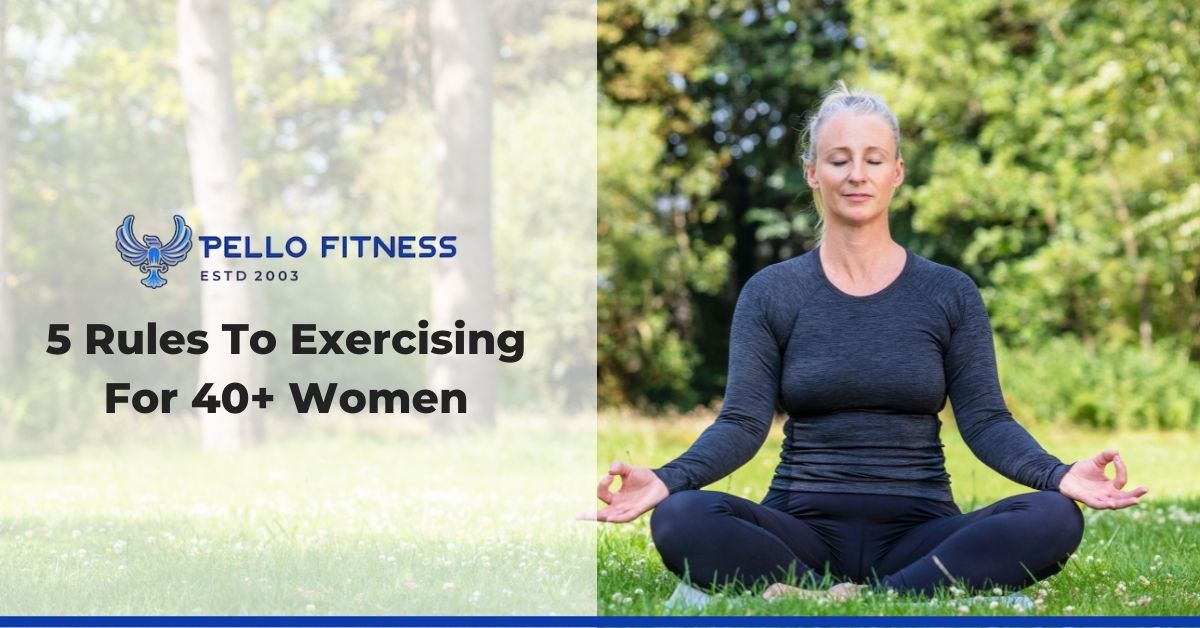|
Regular exercise is one of the most important things you can do for your health. But once you reach your 40s, you'll start encountering changes to your body that could mean changes to your usual fitness routine. Whether you're experiencing perimenopausal or menopausal symptoms, or you're simply looking to stay on top of your health in your 40s, now is the time to pay attention to your body and develop a routine that works for you. Follow these five rules and take charge of your health and fitness. Rule #1. Complete a longer and more thorough warm-up. You most likely ignored standard fitness advice when you were younger and went straight into your workout instead of warming up. If you keep doing that, your body will quickly let you know it doesn't like it. Do you ever experience niggles in specific joints or pain in muscles or tendons? A thorough warm-up is essential to help you gradually increase your body's temperature so that your muscles are ready to work. You should spend at least 10 minutes warming up using a combination of both light cardio and stretching techniques. The aim is to bring your heart rate up slowly, so don't overdo it at this stage of your workout. And just as you should complete a warm-up, you should also cool down properly after your workout. Slow down your activity to help bring your heart rate down and remember to stretch (more on this in rule #2). Rule #2. Stretching is paramount. You might have done the same about stretching as warming up in the past. That needs to change, and stretching should become a vital part of your workouts. Spend about 10-15 minutes working on your flexibility at the end of your sessions. Stretching will help you stay flexible and can help with any post-workout muscle soreness. Focus on stretching the parts of your body that you've used during your workout, holding each stretch for up to 30-60 seconds. You can also use a foam roller to help work your tightest muscles. Workouts that focus on stretching only, such as yoga, can be a practical part of your fitness routine. Consider doing a separate stretch session 2-3 times a week in addition to your post-workout stretching. Rule #3. Allow longer recovery between workouts. While you might be used to working out every day, you might want to consider taking additional days to recover between strenuous workouts. Your muscles can take longer to heal as you move past 40, so give yourself more time to recover if you find that muscle soreness impacts your workouts. You can always switch to a low-impact session like walking or swimming between strength training days and more intensive workouts. Eating a protein-rich diet can also help you give your muscles the fuel they need to recover. Rule #4. Embrace low impact cardio to protect joints. All types of physical activity will have some effect on your joints. Still, high-impact exercises can put unnecessary strain on your body. All that jumping and short, sudden movements can lead to injuries - especially if these are new exercises to you. Low-impact workouts can help you keep fit without putting added pressure on your joints or muscles. These can be walking, dancing, swimming, Pilates, or even a low-impact cardio class. Rule #5. Include steady-state cardio and HIIT are for heart health. While low-impact exercise is essential for protecting your joints, there are a lot of benefits that come with high-intensity activities - especially for your heart health. Let's get one thing straight, though. HIIT doesn't only mean burpees, jumping, and all sorts of exercises where you move quickly. You can perform high-intensity cardio while cycling, rowing, or using a ski erg machine. HIIT (High-Intensity Interval Training) exercises are ideal for getting your heart rate high, pushing your heart to become stronger with each session. If you haven't done such work in the past, start with a few minutes of it twice a week and build it up. Steady-state cardio is an effective fat burner and is easy to do in a gym environment but also outdoors. Think of gentle cycling, walking, working on the cross-trainer, or leisure swimming. Cardio is essential for your heart health. It would be best if you aimed to complete 2-3 cardio sessions a week at least, totaling 150 minutes of vigorous exercise. Conclusions While you will want to think about adjusting your fitness routine in your 40s, listening to your body and doing what feels right for you is essential. If you've always maintained a regular fitness routine, some exercises will still be appropriate for you. If you begin to experience signs of an injury, stop exercising immediately and get any niggles checked out.
Working with a trainer can help ensure your fitness routine is right for you. From creating an appropriate schedule to helping you perfect your form, a personal trainer could be just what you need to get exercise tips for menopausal women. If you'd like a commitment-free chat with us, feel free to get in touch.
0 Comments
Leave a Reply. |
AuthorZach Pello Archives
June 2023
Categories |
Services |
Company |
|
|
© COPYRIGHT 2018. ALL RIGHTS RESERVED.
|
Website Design by My Personal Trainer Website
|


 RSS Feed
RSS Feed